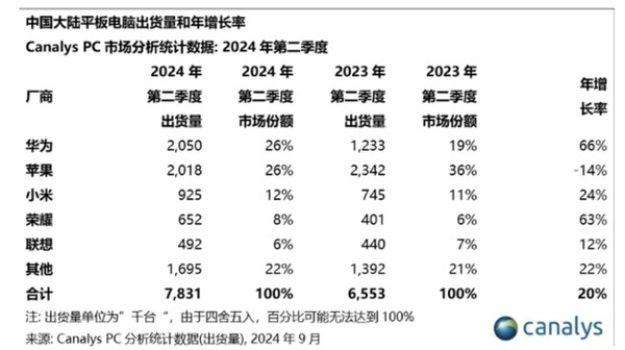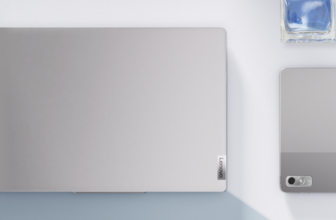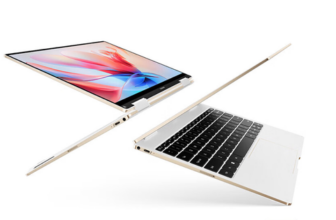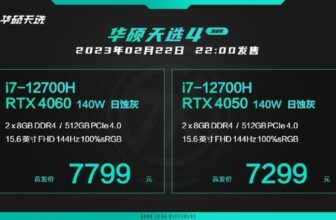At the end of September, market analysis agency Canalys released the latest report, announcing tablet shipments and annual growth rate data in mainland China in the second quarter of 2024. Data shows that Huawei’s tablet shipments in the second quarter were 2.05 million units, with a market share of 26%, and an annual growth rate of 66%, while Apple’s second quarter shipments were 2.018 million units, with a market share of 26%, and an annual growth rate of -14%. The following brands are Xiaomi, Honor, and Lenovo, with the top five brands accounting for 78% of the market share. This shows that Huawei can overtake Apple shortly if this trend continues. With Huawei’s rapid growth in tablet shipments, Huawei can overtake Apple and solidify its position as a leader in the market.
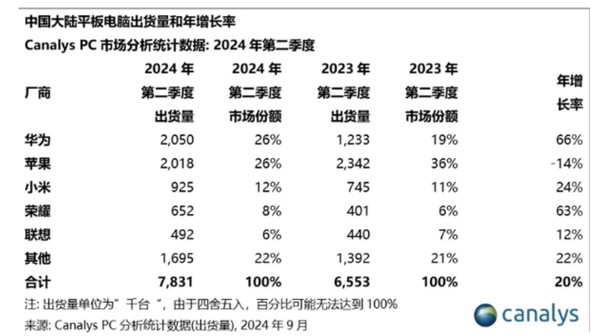
Among them, two brands, Huawei and Honor, are particularly eye-catching, both achieving annual growth rates of more than 60%. Huawei competes with Apple at the top, and Huawei can overtake Apple with its rapid growth. While Honor pursues it with all its strength, completing a counterattack with a rapid increase in market share, Huawei’s momentum in the tablet market is undeniable. Today, we will take a look at why Huawei can overtake Apple in this space, a market that Apple once dominated but now faces stiff competition from Huawei. This kind of transcendence is likely to become the norm for market reversal as Huawei terminals gain momentum, which is actually a good thing for domestic tablet manufacturers.

By this year, Huawei has been in the tablet field for over ten years. Ten years ago, few knew the brand. Today, it leads the tablet market. Huawei now offers four product series: MatePad, MatePad SE, MatePad Air, and MatePad Pro. These cater to various consumer groups and price ranges, from as low as 1,000 yuan to as high as 10,000 yuan. This wide range allows consumers to select products that best fit their needs, whether for audio-visual entertainment or painting creation.
Huawei has not only created a complete product matrix but also clearly differentiated each series. This ensures users enjoy a unique experience. Take the MatePad SE, for example. Despite its affordable price, it features a large eye-protecting screen, the Hongmeng system, and an all-metal body. On the other hand, the MatePad Pro series offers superior screen quality, a more powerful Hongmeng system, a thinner and lighter design, and better sound effects. These enhancements make the products more valuable to consumers and investors alike.
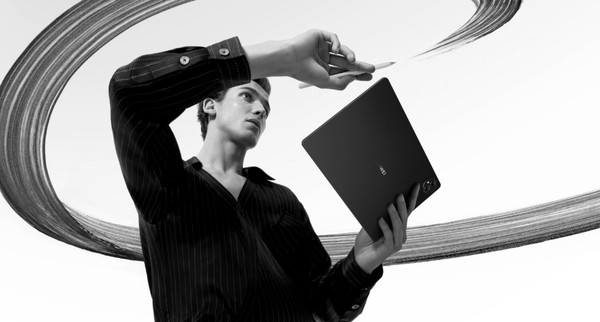
In the mobile phone and tablet industry, there’s a saying that “Huawei’s high-end products are more cost-effective.” This perception reflects Huawei’s decades of hard work. At first, it might seem like the brand is discouraging consumers from buying mid- to low-end products. However, I recommend Huawei’s high-end products, which I consider a success. Products like the Mate60 series and Mate XT Ultimate are difficult for other domestic manufacturers to match.
When it comes to tablet products, Huawei has also not disappointed consumers. Through comprehensive innovation in software and hardware, users can find functional points that meet their needs on Huawei tablets. For example, the cloud clear soft light screen hardware, Huawei MatePad 11.5″S debuts the cloud clear soft light screen, which brings the tablet’s eye protection and reading and writing experience to a new level. The advantage of the cloud clear soft light screen is that it protects the eyes more clearly and allows reading It is more comfortable to write. It uses anti-glare nano-etching technology to eliminate 99% of interfering light. Additionally, multi-layer nano-magnetic optical coating technology protects your eyes while reducing screen reflectivity. The market responded strongly once it was launched.
Another example is the recently released Huawei MatePad Pro 12.2-inch. It features a double-layer OLED cloud-clear soft light screen, with a peak brightness of up to 2000 nits. The frame is only 4.6mm, and the screen-to-body ratio is up to 92%. It also supports a 144Hz refresh rate. Compared to the new iPad Pro, it has a clear advantage. The newly released Huawei MatePad Air also features a new generation cloud-clear soft-light screen with a peak brightness of 1000 nits and supports a 144Hz refresh rate. This provides a smoother experience than the iPad Air. Huawei uses the MatePad Pro series to compete with Apple’s iPad Pro and the Air series to benchmark the iPad Air. So far, this strategy has proven successful.
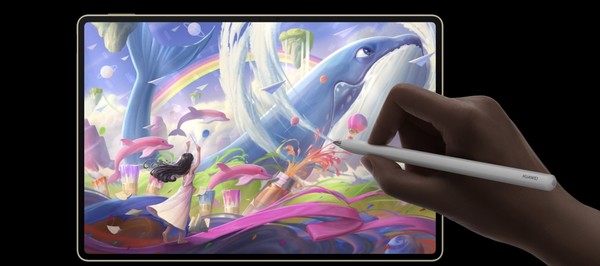
Huawei has integrated tablets with other terminal products using HarmonyOS, creating a seamless multi-scenario ecosystem experience. As it explores user needs, Huawei launched its self-developed painting software, Tianshenghui App, and note-taking software, Huawei Notes, to better serve entrepreneurial users. For office productivity, Huawei tablets use a PC application engine, offering desktop-level software like WPS Office, CAJViewer, and Edraw. Furthermore, in response to the AI trend, Huawei tablets now leverage Ascend and Pangu large models. Xiaoyi’s upgrades have greatly improved the tablet’s intelligence and enhanced the writing and drawing experience.
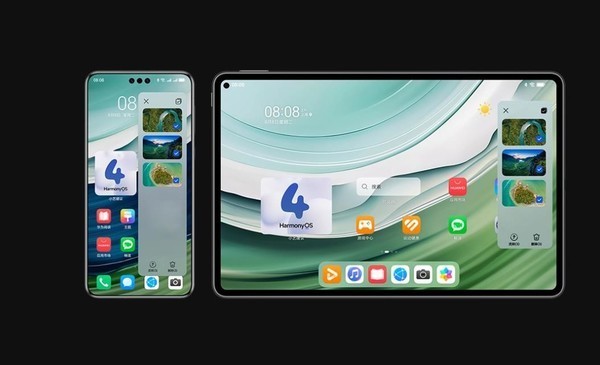
Huawei is constantly improving its multi-screen collaboration capabilities. This enhances the cross-end functionality of tablets, mobile phones, PCs, and other products. Currently, Huawei rarely promotes this feature, as it has matured and become a standard for tablets. There’s no need for frequent announcements without significant breakthroughs. However, with HarmonyOS NEXT, the new architecture improves overall performance by 30%. A new distributed soft bus boosts connection speed by 3 times, the number of connections by 4 times, and reduces power consumption by 20%. This is ideal for multi-screen synergy, and I believe it will be highlighted in future product launches.
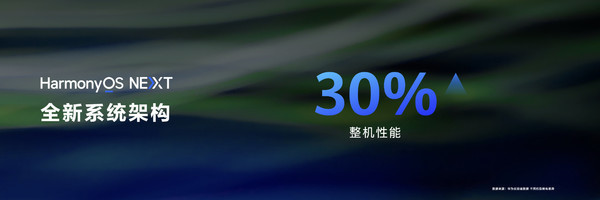
In addition to excellent product quality, Huawei’s tablet success is closely tied to its full-scenario ecosystem. This is an advantage new tablet brands have, which established companies lack. As we discussed before, mobile phone brands like Huawei, Honor, and Xiaomi have made rapid progress in notebook production, largely due to their ecosystem. In the ecosystem, terminal products are no longer isolated islands of information. They can realize the flow of information and experience, allowing users to simplify complexities at any time in the ecosystem. This is a trend and one of the magic weapons for manufacturers to compete in the AI era.
For more insights on the tech industry and product reviews, feel free to explore Tiny Deals Blog.
